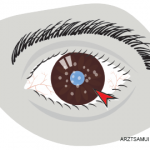A newer long-acting intravitreal steroid preparation from pSivida, Iluvein, currently under phase III trials for posterior noninfectious uveitis, can be inserted in the office and may last up to three years, says Dr. Sheppard.
4. Enlist an Ophthalmologist’s Help for the Treatment of Dry Eye Disease
Rheumatologists often recommend the use of artificial tear supplements for patients with dry eye, says Alan Baer, MD, director, Johns Hopkins Jerome L. Greene Sjögren’s Syndrome Center, Johns Hopkins University School of Medicine. However, a variety of other higher-level treatment options is available, including topical cyclosporine drops. Plus, “in some cases, secretagogues like pilocarpine and cevimeline can help promote tear flow and relieve dry eye symptoms,” Dr. Baer says.
Sometimes a patient with an autoimmune disease can have dry eye but not feel the symptoms, which is yet another reason why ophthalmologists should be part of that person’s care, Dr. Akpek says. Without treatment, the patient may experience corneal scarring or a decrease in vision.
Ophthalmologists can also recommend as appropriate the use of punctal plugs, changes to the patient’s environment (e.g., reducing exposure to fans and wind), nighttime ointments and other treatments to help relieve symptoms of dry eye—some of which may sound minor to clinicians but are actually quite irritating to patients.

5.Don’t Back Off of Therapy Too Quickly
Dr. Foster shares the example of a patient with Behçet’s disease on infliximab or azathioprine whose uveitis is in remission. A year goes by, and the rheumatologist decides to cut back on the patient’s treatment. Unfortunately, the uveitis returns. Instead, Dr. Foster advises sticking with aggressive, prolonged, closely supervised therapy to avoid recurrences of serious eye diseases.
6. Hold Simultaneous Clinics with Your Ophthalmic Colleagues When Possible
Dr. Sheppard believes that a special clinic involving both specialties for the treatment of tough patients can save patients time (they come for one appointment vs. two separate ones) and can increase collaboration among physicians. However, he acknowledges that it can be difficult to get patients and the staff members involved from a variety of physicians’ offices in one place at the same time.
If a clinic is not possible, then Dr. Sheppard is also a fan of frequent appropriate referrals, which can offer patients better care and help increase regular collaboration and business between the two specialties. “Teaming with a rheumatologist for these patients is almost always beneficial,” he says.
7. Expect Certain Treatments to Be Part of the Ophthalmologists’ Armamentarium in the Future
Ophthalmology has a “stepchild” image in medicine, so it has to rely on research done in other specialties that can benefit eye care, Dr. Foster says. In that realm, there is research underway with tumor necrosis factor–alpha inhibitors to be used as future treatments for ocular inflammation. Until now, any such use has been off-label, he says.


